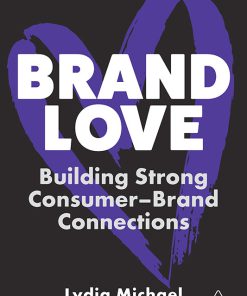Corporate Brand Design Developing and Managing Brand Identity 1st Edition by Foroudi Mohammad Mahdi, Pantea Foroudi ISBN 9781000459067 1000459063
$50.00 Original price was: $50.00.$25.00Current price is: $25.00.
Corporate Brand Design Developing and Managing Brand Identity 1st Edition by Foroudi Mohammad Mahdi, Pantea Foroudi – Ebook PDF Instant Download/Delivery: 9781000459067 ,1000459063
Full download Corporate Brand Design Developing and Managing Brand Identity 1st Edition after payment

Product details:
ISBN 10: 1000459063
ISBN 13: 9781000459067
Author: Foroudi Mohammad Mahdi, Pantea Foroudi
Corporate Brand Design Developing and Managing Brand Identity 1st Edition Table of contents:
PART I INTRODUCTION TO CORPORATE BRAND DESIGN MANAGEMENT
1 THE EMERGENCE, DEVELOPMENT, AND CHANGING USES OF CORPORATE BRAND DESIGN, 1760 TO DATE
Introduction
Research background
Conclusion
References
2 CORPORATE BRAND DESIGN MANAGEMENT FROM DIFFERENT PERSPECTIVES
Introduction
Background to corporate brand design management
Perspective 1: Graphic design – visual and verbal cues
Perspective 2: Integrated communication approach
Perspective 3: Organisational approach
Perspective 4: Marketing paradigm
Perspective 5: Interdisciplinary/multi-disciplinary approach paradigm
Conclusion
Key terms and definitions
Acknowledgement
References
PART II CORPORATE BRAND SIGNATURE MANAGEMENT
3 CORPORATE BRAND SIGNATURE MANAGEMENT: LOGO, DESIGN, TYPEFACE, AND COLOUR
Introduction
Background to corporate brand signature management
Corporate brand signature concept
The elements of the corporate brand signature
Corporate brand typeface
Corporate brand colour
Corporate brand design
Corporate brand name
Conclusion
Key terms and definitions
References
4 CORPORATE BRAND SIGNATURE: IMAGE AND REPUTATION
Introduction
Background to corporate brand image and reputation
Corporate image concept
The corporate reputation concept
Corporate brand design, corporate image, and corporate reputation
Conclusion
Key terms and definitions
References
PART III CORPORATE ARCHITECTURE DESIGN
5 CORPORATE ARCHITECTURE DESIGN MANAGEMENT
Introduction
Background to corporate architecture design management
Architecture management construct
Defining the architecture concept
Architecture and decor and artifacts/symbolic artifacts
Architecture and spatial layout and functionality/physical structure
Architecture and ambient conditions/physical stimuli
Conclusion
Key terms and definitions
References
6 CORPORATE ARCHITECTURE DESIGN AND HUMAN FACTORS, NEEDS, AND PERFORMANCE
Introduction
Background to corporate architecture design and human factors, needs, and performance
Architecture and the human factor
Architecture as an expression of social, economic, and technological realities
Architecture and human performance
Architecture and human needs
Architecture and aesthetic
Architectural perception and assessment
Architecture, human behaviour, and attitudes towards the corporation
Architecture and corporate communication
Architecture and corporate image
Conclusion
References
7 CORPORATE ARCHITECTURE DESIGN, CORPORATE IDENTITY, AND IDENTIFICATION
Introduction
Background to corporate architecture design, corporate identity, and identification
Corporate identity and architecture relationships
Corporate identity and identification relationships
Architecture and identification relationships
Corporate identity dimensions and architecture dimensions relationships
Corporate visual identity and architecture
Philosophy, mission, value, and architecture
Communication and architecture
Conclusion
Key terms and definitions
References
PART IV CORPORATE BRAND WEBSITE DESIGN
8 CORPORATE BRAND WEBSITE DESIGN MANAGEMENT
Introduction
Background to corporate brand website design management
Corporate brand website design favourability concept
The elements of corporate brand website design favourability
Navigation
Visual
Information
Usability
Customisation
Security
Availability
Website credibility
Customer service
Perceived corporate social responsibility
Perceived corporate culture
Conclusion
Key terms and definitions
Acknowledgement
References
9 CORPORATE BRAND WEBSITE DESIGN, IMAGE, IDENTIFICATION, AND LOYALTY
Introduction
Background to corporate brand website design, image, identification, and loyalty
Corporate website favourability and corporate image
Corporate image and corporate reputation
Corporate reputation and consumer–company identification
Consumer–company identification and loyalty
Corporate website favourability, satisfaction, and image
Corporate website favourability, attractiveness, and image
Conclusion
Key terms and definitions
Acknowledgement
References
PART V CORPORATE BRAND SENSUALITY
10 EVOLUTION OF BRANDING: TOWARDS AN HISTORICAL UNDERSTANDING OF THE CONCEPT BRANDING, EXPERIENCE, AND SENSES
Introduction
Background
The emergence of ‘branding’: A snapshot from 1920s to 1960s
The emergence of ‘experience’ in marketing
Background
An introduction to the concept of ‘experience’
The emergence of ‘experience’ in marketing
Solutions and recommendations
‘Experience’ in marketing: How to conceptualise it?
Future research directions
Conclusion
Key terms and definitions
Note
References
11 EVOLUTION OF SENSES: FROM NO-NONSENSE ERA TO THE RISE OF SENSORY MARKETING
Introduction
Background
From no-nonsense era to the rise of sensory marketing
1929–1970: No-nonsense era
1970–1990: The rise of advertisements
1990 to date: The rise of sensory marketing
Future research directions
Key terms and definitions
References
12 SENSORY MARKETING: ENVIRONMENTAL PSYCHOLOGY THEORY APPROACH
Introduction
Background
Environmental pyschology theory and S-O-R framework
Issues, controversies, problems
Future research directions
Key terms and definitions
References
13 SENSORY MARKETING: VISUAL CUES AND AUDIAL CUES
Introduction
Visual cues: Background
Practical approach to visual cues
Audial cues: Background
Practical approach to audial cues
Key terms and definitions
References
14 SENSORY MARKETING: OLFACTORY CUES AND HAPTIC CUES
Introduction
Olfactory cues: Background
Literature review
Haptic cues: Background
Literature review
Practical applications
Olfactory cues
Haptic cues
Key terms and definitions
References
15 GUSTATIVE SIGNATURES AS CORPORATE BRAND IDENTIFIERS: EXPLORING THE SENSUALITY OF TASTE AS A MARKETING STRATEGY
Introduction
Background
Gustative signatures
The mouth/brain relationship
Sensorimotor sensations
Olfactory sensations
Oral haptic sensations
Chemo-sensations
The taste/flavour relationship
Discussion
Gustative sensuality and product consistency
Gustative sensuality and customer experience
Gustative sensuality and the consumption environment
Auditory cues
Visual cues
Tactile cues
Social cues
Sensuality and place identity
Conclusion
Key terms and definitions
References
INDEX
People also search for Corporate Brand Design Developing and Managing Brand Identity 1st Edition:
corporate identity vs corporate design
corporate design definition
corporate branding design
developing corporate brands
Tags:
Foroudi Mohammad Mahdi,Pantea Foroudi,Corporate Brand,Managing Brand Identity
You may also like…
Business & Economics - Sales & Marketing
Lecture Note 01 Strategic Brand Management:Strategic Brand Management Process 1 st Edition Candy Liu
Arts - Graphic Arts
Brand by Hand Blisters Calluses and Clients A Life in Design Jon Contino
Arts - Business of Art
Business & Economics - Sales & Marketing
Business & Economics - Sales & Marketing
Business & Economics - Sales & Marketing
Business & Economics - Sales & Marketing











